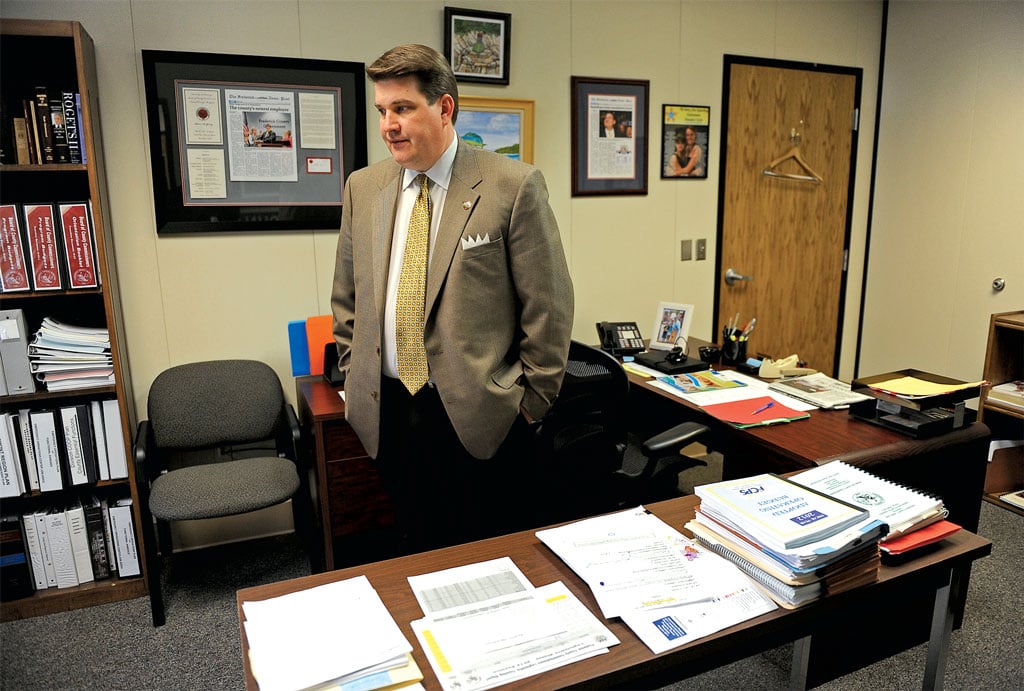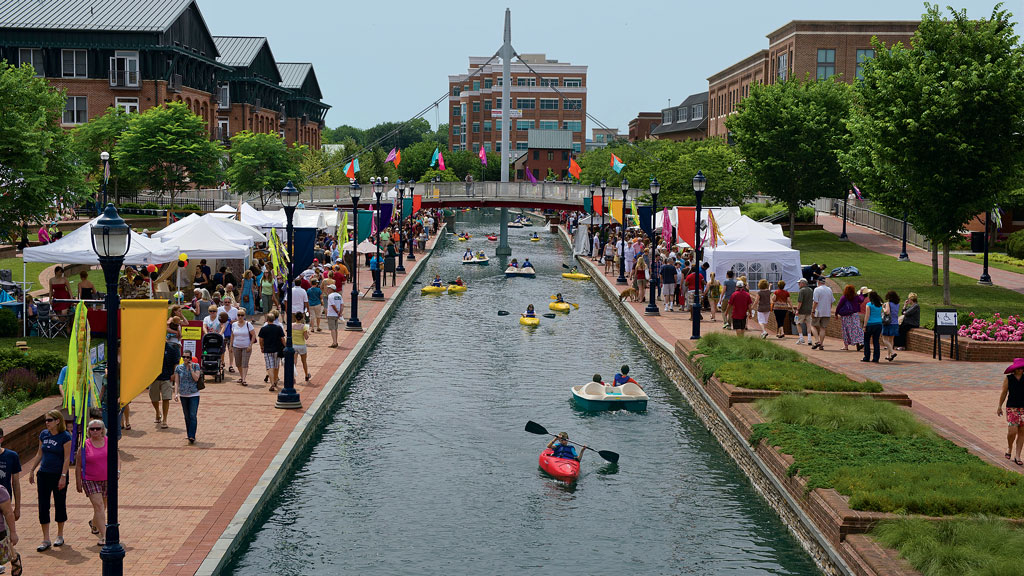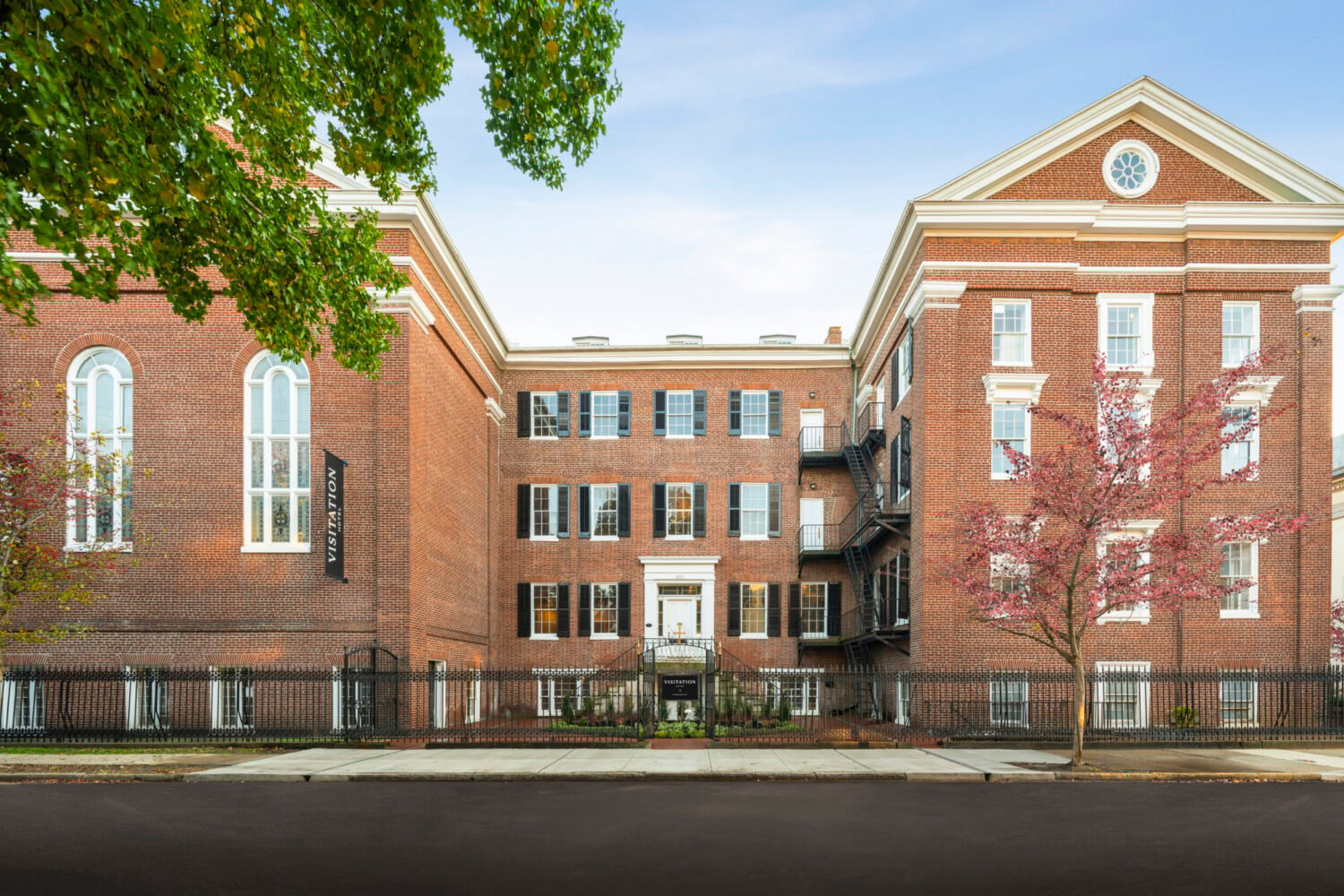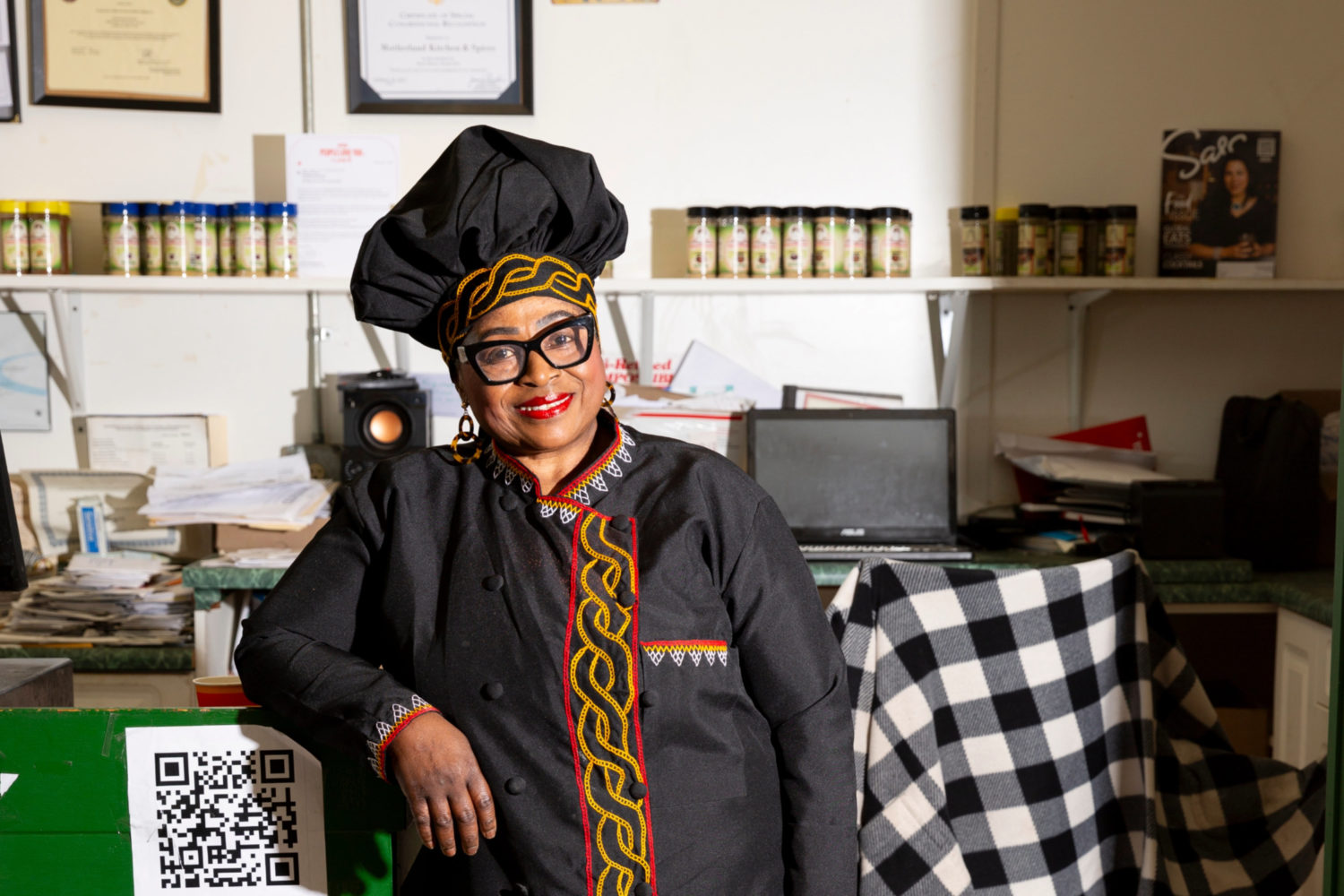In St. John’s Roman Catholic cemetery in Frederick is the grave of Roger Taney, the former Supreme Court chief justice and Frederick resident who wrote the 1857 Dred Scott decision, which found slaves to be property, not people. Taney lies less than two miles from Barbara Fritchie, immortalized at age 95 for, as legend has it, defiantly waving the 38-star flag at Confederate soldiers as they headed up West Patrick Street to the Battle of Harpers Ferry in 1862. In John Greenleaf Whittier’s poem about the confrontation, Fritchie declares: “ ‘Shoot, if you must, this old gray head, / But spare your country’s flag.’ ”
Maryland—at least those parts outside the Beltway—has long split over whether the state is essentially southern or northern, rural or urban, rebel or Union. Nowhere is that indecision felt more strongly than in this 18th-century market town of 69,000 near the Monocacy River, a bare 40 miles northwest of DC. Like much of the South, Frederick County has long since gone Republican—it last went for a Democratic President in 1964—even if the area’s former longtime congressman, Roscoe Bartlett, was considered something of a moderate in his day. The rebel Stars and Bars are a common sight around Frederick, made more pointed by residents’ occasional friction with a tiny but active pocket of Klansmen out in the county.
“Frederick is a conservative community, generally speaking,” says Al Weinberg, a former journalism professor at Hood College and onetime publisher of the local edition of the Gazette. “There’s no way you can say it is anything but that.”
But since about the turn of the millennium, Frederick, the county seat, is also one of Maryland’s fastest-growing cities, its charming brick rowhouses and its walkable, suddenly bustling downtown proving popular with seniors (Frederick is the state’s fastest-growing county among this group) and, increasingly, millennials. Subdivisions have mushroomed on the former farms around the city, while in tiny hubs such as Urbana, south along I-270, Washington keeps extending its suburban reach. The newcomers have brought with them Maryland’s other, bluer side: suburban, liberal, and ethnically diverse.
“It’s an entirely new demographic,” says David Whitaker, chief of comprehensive planning for the county. “The millennials are bringing entrepreneurship, and I see signs for things I’ve never seen before.” Liberal Democrats have been elected to the state assembly and local offices. Market Street, a once-sleepy main drag, has become a weekend destination, with restaurants, bars, vintage shops, and other quirky, independent retailers.
Whitaker marvels at a poster he saw for Gangstagrass, a band from Brooklyn. “There is a mixed gangsta-hip-hop and bluegrass band playing in Frederick,” he says.
To the old-timers who have run Frederick city and county for generations, the boom has meant plenty of jobs and revenue. In 2010, a pro-development “conservative team” was elected to the county’s five-seat board of commissioners, including real-estate agent Billy Shreve; Kirby Delauter, a contractor and a sixth-generation county resident from Thurmont; and commission president Blaine Young. One of the commission’s first acts was to reduce developer fees and ease the way for more building by reversing restrictions on selling and subdividing parcels.

But at the same time, the conservatives tried to hold the line on another aspect of growth: immigration. The foreign-born population in the county, mostly Latinos, increased by 12 percent from 2010 to 2014, according to state data. The number of Latinos in county public schools has been growing at a faster rate than the student body as a whole, and the presence of the newcomers is evident. At Frederick’s county fair last September, a Univision booth blasted salsa music across a makeshift dance floor opposite a large vendor of Confederate memorabilia.
Official Frederick has been less than welcoming to the newcomers. In 2008, Sheriff Chuck Jenkins, a Republican, empowered his deputies to check the immigration status of anyone they detain, under a Homeland Security program called 287(g). Undocumented aliens may be turned over to the feds. “Through our cooperation and partnership with [Immigration and Customs Enforcement], we have very effectively built a wall around Frederick County,” Jenkins told Congress in April.
In 2012, Young, Delauter, and Shreve pushed through an ordinance making English the county’s official language. Their purpose, they said, was to save taxpayers money—and stave off the kind of hospitable reputation that, according to Delauter, turned neighboring Montgomery County into a magnet for immigrants who need social services. “It’s a sanctuary county and is just getting flooded,” Delauter says.
Midway through his term as commission president, Young and his allies on the body pushed to switch Frederick to Maryland’s “big county” charter form of government, with a seven-member council and a powerful county executive. But the inaugural race for the top job quickly became a fight over Frederick’s character. Young lost to Jan Gardner, a former commission president, who since taking office has rolled back the English-only law and supported the creation of more affordable housing.
Gardner also ended practices that made a seat in government a kind of fiefdom. By executive order, she made it illegal for council members and county executives to bid on county contracts. She took away members’ dedicated parking spots, prompting loud complaints from Delauter. When the Frederick News-Post reported his fulminations, Delauter promised to sue the reporter if she used his name without his permission. The paper responded by printing an editorial in which the first letter of each line spelled out Delauter’s name. (Today Delauter says the contretemps was born of frustration and “my ignorance of how to get my point across.”)
At times, the fallout became personal. Gardner demoted a county staffer who’d had a romantic relationship with Blaine Young when he was president of the commission, a move that caused Young to accuse Gardner of seeking revenge. (Now out of public life, Young is franchise-and-development manager for NaturaLawn of America. In February, he was arrested in a prostitution sting at a hotel near BWI Airport. He was found guilty of three counts in August.)
For more than a year, the council meetings at Winchester Hall, the county building on East Church, have been tense. Shreve initially took to leaving meetings early and, when he was in attendance, registering his “no” vote with a resounding “Absolutely not!”
A steadying hand—and a crucial swing vote—has come from Bud Otis, former chief of staff to Roscoe Bartlett. Otis has handed Gardner victories on expanding the school budget and recently shepherded a far-reaching ethics bill into law. Otis represents many Frederick old-timers who largely accept the changes, and the people, coming to the area.
Frederick’s boom resulted from two 20th-century catastrophes. In the 1970s, downtown emptied as Sears and JCPenney, its middle-class mainstays, moved out to new malls. Frederick was confronting what was happening to many communities: Commerce was leaving the urban center. Then in October 1976, several days of heavy rain caused Carroll Creek, a tributary of the Monocacy that cuts along downtown’s southern tier, to overrun its banks, flooding much of historic Frederick up to the first floor.
For more than a decade after the flood, then-mayor Ron Young—Blaine’s father and currently the area’s Democratic state senator—spearheaded a major effort to rebuild, kick-started by $20 million in state funds to construct a floodwater-containment system. Consulting with Jim Rouse, the developer behind Baltimore’s Inner Harbor, Young oversaw the creation of commercial buildings along Carroll Creek, which combined new construction with converted 19th-century warehouses. Land on the reclaimed floodplain was turned into a park that snakes through the heart of Frederick.
Development in downtown has been almost continuous since then, and each new phase has fed the revival of Market Street’s retail corridor. Hood College, the Army’s medical-research installation at Fort Detrick, and the nearby drug manufacturer AstraZeneca all nursed the city through its lean years. But in the early 2000s, artists, musicians, and young professionals discovered the city’s commodious and cheap rowhouses. In 2008, celebrity chef and Frederick native Bryan Voltaggio opened his acclaimed restaurant Volt on North Market. To many, his arrival felt like an official announcement of Frederick’s rebirth.
Today the city seems to have hit a cultural sweet spot, appealing to a mobile young workforce that puts a premium on quality of life—a 20-minute drive from the Appalachian Trail, the county also boasts a long network of bike paths. “Just look at how people want to live,” says Gardner. “If you want a bikeable, walkable community connected to an urban core, the city of Frederick is the place to be.”
Walking Frederick on a summer weekend can give anyone struggling to keep a toehold in the District a case of rowhouse anxiety: A six-bedroom Civil War–era house with crown molding and hardwood floors recently sold for less than $300,000. “I’ve told friends from high school, ‘Come back or you’re going to miss it,’ ” says Brennan Gmeiner, 25, who returned home after college to work for a financial-services company.
Still, Frederick’s future, its balancing act between rural and urban, feels precarious. On weekend nights, Market Street is alive with young crowds spilling out of places like Isabella’s, a tapas joint that has live music after 10 on Friday and Saturday nights. Sleek restaurants such as Michael Tauraso’s Tasting Room have joined Volt, and Flying Dog and other local breweries have put Frederick on the beer tourist’s map. But for every hot spot, there’s an empty building along Market Street.
Some see downtown’s raffish side as a virtue. “We’re all looking for that sense of history and authenticity,” says Hilary Davies, a former Montgomery County math teacher who comes to the city to volunteer at the Potters’ Guild, a shop owned and run by local artisans. “You get the feeling you are doing something edgy when you are in Frederick.”
Edge, however, may not serve long-term growth. Tom England, who founded Dancing Bear Toys and Gifts 16 years ago on North Market Street (it has since moved to East Patrick), says the key isn’t simply attracting young people with cheap digs and nightlife but keeping them as they start families and look for permanent homes. Gardner’s emphasis on school funding and supporting downtown’s small businesses is aimed directly at converting the new population into permanent residents. If the city can sustain its boom, she says, Frederick could become a needed economic engine for the region.
The county’s conservatives could, by stinting on education or creating an atmosphere of intolerance, crush Frederick’s newfound buzz if they regain power. Billy Shreve says the divisions over the direction the county should take are not old versus new—“The old Frederick went away a long time ago”—but a new battle of legislative versus executive power. When residents see how much power the executive now wields, Shreve predicts, the pendulum will swing back toward the county’s traditional ways of doing business.
He could be right. There are rumblings that Jenkins, the county’s anti-immigration sheriff, might try to oust Gardner in 2018.
Anyone trying to take office on the back of the rural vote, though, had better hurry. Jennifer Dougherty, Frederick’s former Democratic mayor, notes that the conservative pols eager to undo “smart growth” restrictions on subdivisions are voting for their own demise. “If Mr. Smith sells his farm and moves to Florida, there are now 800 families living there who came from somewhere else,” she says, and the pressure for better schools, parks, and other services will intensify. Like it or not, Dougherty says of the county’s residents, “they are now urbanites.”
This article appears in our September 2016 issue of Washingtonian.


















